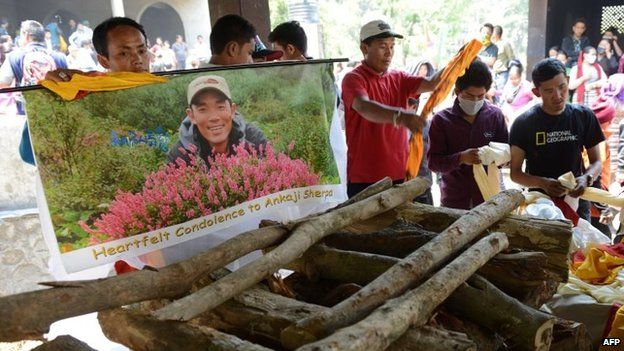Everest avalanche: Sherpas demand more compensation
- Published

Sherpa guides in Nepal have demanded more compensation for the families of 13 of their colleagues killed in an avalanche on Mount Everest on Friday.
Three more guides are still missing after the accident.
In a statement, the Sherpas demanded compensation higher than the $400 (£238) offered by the government, as well as higher insurance payments.
Friday's was the single deadliest accident in modern mountaineering on the world's highest peak.
The avalanche struck in an area just above Everest base camp at 5,800m (19,000ft).
In the statement, made available to the BBC after a meeting at base camp on Monday, the Sherpas also demanded better measures to ensure speedy rescue and treatment facilities for guides.
Some expeditions have been cancelled as a mark of respect.
Correspondents say that Sherpa guides have an average income of around $5,000 a year - a substantial amount in Nepal - and often support their extended families.
Path 'unstable'
The guides had climbed up the slope early on Friday morning to fix ropes for climbers and prepare the route.
The avalanche struck a passage called the Khumbu Icefall, which is riddled with crevasses and large ice boulders that can break free without warning.
Although relatively low on the mountain, climbers say it is one of its most dangerous points - but there are no safer paths along the famous South Col route first scaled by Sir Edmund Hillary and Tenzing Norgay in 1953.
An injured survivor told his relatives that the path was unstable just before the avalanche hit.
Sherpas often make 20-25 round trips to carry kit and supplies to advanced camps, exposing them to greater risk.
It was the first major avalanche of this year's climbing season on Everest, which has been scaled by more than 3,000 climbers.
The rising number of tourists has raised concerns about safety and environmental damage, although Nepal still plans to cut fees from next year for those wishing to make the climb.
Some 250 climbers have died on the mountain, which is on the border between Nepal and the Chinese region of Tibet and can be climbed from both sides.
- Published18 April 2014
- Published18 April 2014
- Published3 March 2014
- Published21 February 2014
- Published29 April 2013
- Published2 August 2013